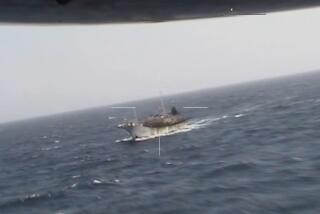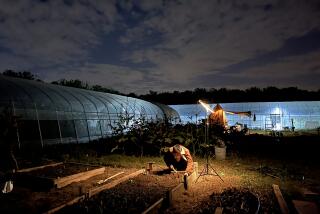China Reaps a Bonanza in Fish Farming
- Share via
YANTAI, China — The seas around this northeastern fishing port have been swept almost clean. Gone are the yellow croakers and cuttlefish. Even the usually plentiful sardines are in danger.
Inside Zhang Rihuan’s nets, however, gleams a shimmering harvest of sea bass. For Zhang, like many others in Yantai, is farming his fish.
Its coastal waters depleted of many of the most valued species, China is combining modern and ancient aquaculture techniques to secure a plentiful supply of fresh crab, carp, abalone and other aquatic products for its 1.3 billion people.
Many of the boats that leave Yantai’s harbor, in Shandong province 300 miles southeast of Beijing, head these days for waters as far away as Africa and the South Pacific, hoping to fill nets that might come up empty in seas nearby.
But even deep-sea fishing has its limits. So the government is gradually reducing the number of fishing vessels it licenses and is encouraging fishermen to opt for the better incomes and more stable livelihood that aquaculture provides.
The world’s largest fish producer, China’s boats and fish farms harvested 23.5 million tons of aquatic products in 1995. The $5.3-billion-a-year industry employs more than 8 million people. Fish and shellfish from China account for more than 60% of the world’s total aquaculture production.
“This is very, very hard work, but it’s also very profitable,” said Zhang, who manages the seawater fish farm, a South Korean joint venture, for the local fisheries bureau.
In sashimi-loving Japan and South Korea, Zhang’s fish fetch up to $8 a pound--about five times what they would sell for at home.
Zhang’s workers toil from dawn to dusk, grinding frozen fish feed into a paste, transporting plastic trays of it by boat offshore, and scattering it by hand, six or seven times a day, in net enclosures where the fish are raised in their usual ocean environment.
The food disappears instantly in a teeming whirl of silver.
Several dozen women in bright kerchiefs and rain capes sit on rafts amid the nets, using hand-held strainers to sort fish by size, to ensure that bigger don’t eat smaller.
Labor-intensive fish farming makes sense for overpopulated China, satisfying appetites for fish and shellfish too huge to be sustained by “capture” fisheries. But huge fish kills caused by pollution and disease are signals that the industry must be managed carefully.
Yantai, a city of 6.3 million, is blessed with cool northern waters and a harbor well protected from China’s sometimes violent coastal weather. But it was not immune from a devastating epidemic, blamed mainly on poor management and overstocking, that swept through China’s prawn ponds in the early 1990s.
The industry still hasn’t recovered. Nationwide shrimp production remained at 60,000 tons in 1994, down from 220,000 tons in 1991.
The epidemic prompted many of Yantai’s shrimp farmers to adopt less intensive, lower-risk production techniques that, thanks to lower costs and high market prices, still leave them with a good profit margin.
Others have switched to fish polyculture, raising several varieties of fish, shellfish and sometimes seaweed together in the same water.
The practice borrows from freshwater fish-farming methods dating back to at least the 7th century Tang Dynasty.
Chinese carp farmers traditionally have raised several varieties of carp together: grass, bighead, silver, common and mud carp. Each type feeds on a different nutrient: grass and aquatic plants, plankton and organic matter on the bottom.
Some farmers raise fish in flooded rice paddies. The fish feed on weeds and insects, and their waste fertilizes the crops.
“Raising plants and animals together in the same environment makes more sense. The plants put nutrients into the water and the fish do the same for the plants,” said Liu Shengping, director of the fish and kelp nursery at the Yantai City Aquatic Products factory.
Even with polyculture, disease is a constant worry for Yantai’s fish farmers, Liu said.
So is pollution.
Until the late 1980s, toxic red tides were reported mainly in China’s south. By 1989, China reported 12 red tides along its northern coast. By 1996, the number of such toxic tides, fed by phosphate-laden waste water, had risen to 50 a year.
Factories are springing up much faster than waste-water treatment plants. Industrial pollution kills about 200,000 tons of fish in China each year, the Asian Development Bank reports.
Although Yantai’s waters are still relatively clear, Zhang worries that they may not be that way for long.
“It’s definitely going to get worse,” the farm manager said.
Despite such concerns, global aquaculture clearly has a big future: The Japanese are even experimenting with raising tuna in giant ocean pens.
But a doubling of aquaculture production in the next 15 years--an optimistic scenario--would still supply only a fraction of global demand for seafood. Nursing depleted fisheries back to health is the only alternative.
“Even a rapid, environmentally rational expansion of aquaculture can only act as a complement to better management of marine fisheries,” concludes the authoritative, Washington-based World Resources Institute.
China is trying both routes. To help restore some of its diminished marine life, it protects some species and, for two months a year, completely bans net fishing in the Bohai and Yellow seas, the waters nearest Yantai.
But with 180,000 fishermen in the city, the government’s ability to enforce restrictions is limited, said Liu Jianfeng, a manager at Yantai’s Bureau of Oceans and Fisheries.
The only choice is to expand aquaculture, he said.
“This form of fishing is much, much safer than going out on the open seas. And there’s not much point in fishing if there’s nothing left to catch.”
More to Read
Sign up for Essential California
The most important California stories and recommendations in your inbox every morning.
You may occasionally receive promotional content from the Los Angeles Times.










